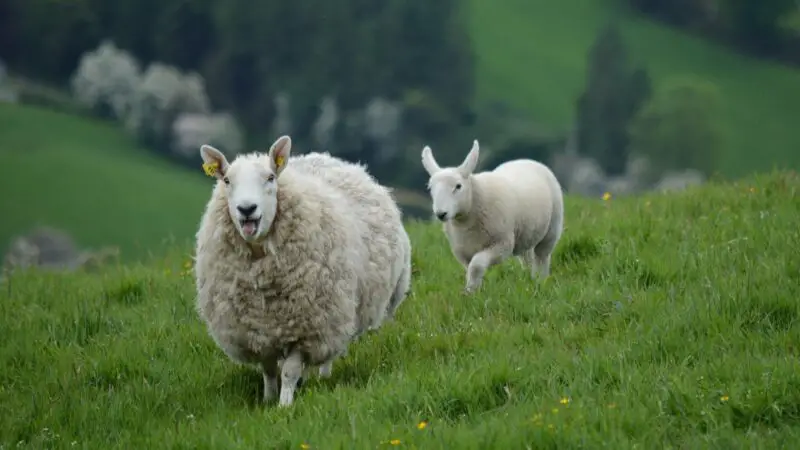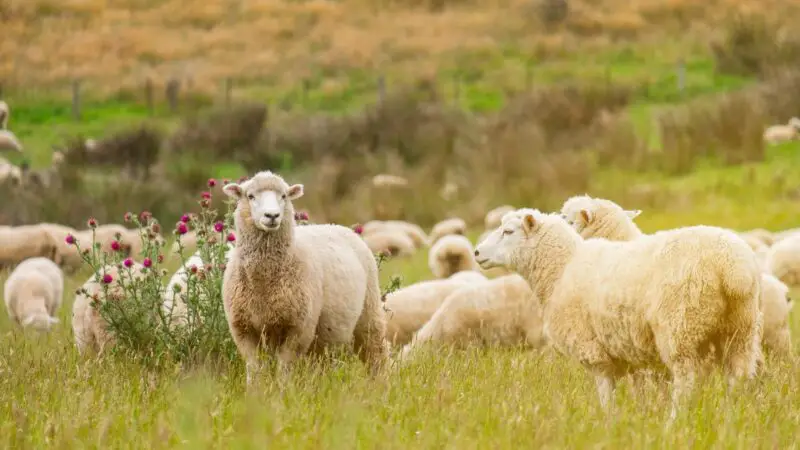Raising sheep does not always happen on a big farm. You can do it on a small-scale farm or work on it as a part-time operation.
The diet of these animals is akin to swine’s as they can be grown through forage and concentrated feed or a combination of these things. Aside from convenience, the amount of profit is the reason that can convince a person to raise sheep.
How much does a sheep cost? A ewe or female sheep for breeding usually costs $250 to $500. A healthy ram can be sold for $500. You can earn money from these animals in a matter of four to six months. Hence, they grow and become mature quickly to be released to the market.
The breeding of sheep occurs from October to December. One to three young can be produced every year and the gestation period is for 5 months.
You can also breed yearlings from ewe lambs. To know further details, which are essential for sheep farming, read the rest of the article.
Are Sheep Easy to Raise?

Sheep are easy to raise, but they only require a higher level of management compared to cattle. Even so, the former is quicker and more efficient in delivering profit than the latter.
Even those without experience can try raising a few ewes first as they can be on the learning curb. They’ll be able to pull it off and have good management practice.
Is It Expensive to Keep a Sheep?

It’s not expensive to keep a sheep as these animals don’t require barns and sheds that require a lot of money to complete. They’re also flexible with their diet, so you can place them in an area where they can forage.
How Much Does Sheep Feed Cost?
If you want to grow a 50-lb lamb, you have to pay for around 450 lb. of feed. Putting your sheep in an area for grazing is a big help. However, you have to remember that lambs are different from each other. Some may require more feed than others.
A 50-lb bag of feed can cost $12, so it’s 24 cents per pound. To be able to market a 450-lb lamb, 450 lb. of feed is needed. So, the total that you need to pay for the feed of one lamb is $108. When setting a budget for sheep feed, add some extra amount in case the need for it arises.
Those who are experienced in raising sheep have a different budget since they know how to grow their grains or add some supplements.
How Much Does it Cost to Feed a Sheep per Month?
Based on the 450 lb. of feed allotment for every sheep, you can spend $75 to $90 per month as you can market this animal in 5 to 6 months. You can even do it in 4 months if you think that it’s the right time for gaining profit.
How Much Does it Cost to Shear a Sheep?
A shearing day is held as an event where shearing a sheep costs $5 to $45. There’s a price range since it depends on the number of sheep and breed. The set-up needs to be paid for $40.
You can also do it yourself as long as you have training regarding this matter. In Texas, you can join the training for $150 if you’re a resident. It’s $250 if you’re not.
Where You Should Buy Sheep?
You can check online for farms that sell sheep, as well as auctions and private treaty sellers that are recommended by the local or producer associations.
What Is the Best Grain to Feed Sheep?
Barley is the best grain to feed sheep. Thus, it’s present in sheep farm operations throughout Europe and Northern America because it’s an excellent source of protein and energy for sheep.
According to the National Research Council, the nutrient content of barley is more favorable than wheat, corn, milo, and oats.
Barley is an exceptional supplement for gestating and lactating ewes, as well as lamb finishing. If you just found out about this and you let your sheep forage, you can switch them to barley, but it must be done through a transition.
When you integrate barley into your sheep’s diet, proper feed management is essential. You have to know that barley ferments quickly.
It means that its starch content also ferments at the same rate. It’s the reason why a slow transition from foraging to barley supplement is advised.
What Factors Drive the Price of a Sheep?

Here are the factors that drive the sheep’s price:
The Time of the Year
Sheep marketed in late summer and early fall have a lower price as lambs can be born from May to September. The lowest price is placed on spring lambs due to low demand, which causes high supply.
In Pennsylvania, lambs sold from August to October are more affordable than those that are for sale at different times of the year.
Direct Selling
You can offer your sheep at a good price if you sell it directly to an interested buyer.
Characteristics
In Ethiopia, sheep are sold based on their live weight, so there’s a rate for every kilo. Apart from weight, age, gender, color, and body condition. Hence, the market price varies.
Marketing Constraints
The marketing constraints that a seller of sheep needs to deal with are transportation and services regarding related information and finances. They result in instabilities and disparities in prices.
These things are likely to happen when the government doesn’t implement marketing infrastructure for trading sheep.
Tips on Buying Sheep
- Before you purchase a sheep, you have to be particular with its needs, like food, water, and shelter.
- When choosing to place the animals in the pasture, you have to build a fence and shelter to protect them from rain and wind. You have to provide quality hay if the pasture is not enough for your sheep.
- Sheep are social animals, so you have to buy a pair.
- You’ll find sheep in different sizes and shapes. Refer to the following breed. For instance, look for Lacaune or East Friesian if you prefer to raise sheep for milk. The ones ideal for meat production are Barbados, Dorper, Katahdin, and Saint Croix.
You don’t need to find a perfect sheep but the right breed for your goals. Whichever you may get, the amount of time and money that you have to invest to raise them is all similar.
- Registered sheep that are raised properly won’t fail to give you profit compared to the animals that have an unknown origin.
- It’s best to buy disbudded sheep as horns can injure other animals. They also cause inconvenience as horns can sometimes get stuck in hay racks and fences.
Earning Profit from Your Sheep
You can mainly earn profit from your sheep through lamb and wool marketing. Lamb marketing is selling live animals, while wool marketing lets you sell wool. As practiced, a sheep can be sheared twice a year for wool.
The lamb industry sets the prime choice of animal that weighs 60 to 80 pounds with only 0.2 covering of fat. Ideally, a sheep should have a large eye rib that has a measurement of 2.6 to 3.2 inches. Wool receipts usually take up 5% to 25% of the producer’s revenue.
Grade indication is how wool is being sold in the market following the sealed bid basis. Some consignors earned through sale price and grade basis. Some producers choose to directly sell their wool to hand spinners.
Some earnings of sheep producers come from meat production. To increase profitability, some raise crossbreeds as they have a higher rate of lambing percentage and wean extra pounds. Also, you can earn more through sheep’s milk.
What Is the Most Profitable Sheep?
The most profitable sheep is the Australian ewe. The fact that Australia is one of the major sheepmeat providers, along with New Zealand supports this statement.
Furthermore, the sheep industry in this country gains higher profit than others because of low-cost production that’s the most diversified and efficient in the world,
Is It Profitable to Raise Sheep?
It’s profitable to raise sheep as it only takes a few months for them to finish and be in the market for sale. This animal has an excellent ability to convert forage, feed, and supplement into high-quality fiber products and meat.
Summary
The cost of sheep varies, as it depends on age, gender, color, and body condition. It takes some money to buy some sheep and start a farm. Even a novice can do it, but the person should start with a few animals.
You’ll surely earn a profit in selling lamb in just a few months. Moreover, you can earn through the sheep’s wool, milk, and meat.
List of Sources
Planning for Your 4-H Sheep Project Animal: Estimating Costs
